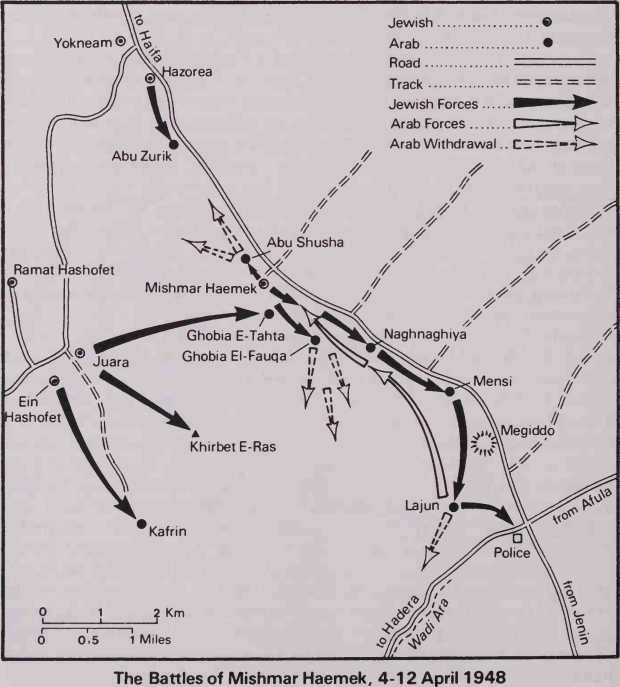The most pressing military problem facing the Haganah Command was the siege of the Jewish community of Jerusalem and the fact that the lines of communication with that community had been severed. It became evident that the convoy system was no longer effective and that a new approach would have to be adopted. As plans were being laid for the breaking of the siege of Jerusalem, Kaukji, who had now consolidated his forces in the Nablus area, began to take the offensive in an endeavour to cut the Jewish lines of communication between Tel Aviv and Haifa and the north. His first move was against the Jewish agricultural settlement of Mishmar Haemek, which lay before the Hills of Ephraim, south of the Carmel ridge, overlooking the valley of Jezreel. The north-south coastal route running between the sea and the Carmel range was by now closed to Jewish traffic; consequently, were Kaukji’s offensive to succeed, he would be in a position to close off the valley of Wadi Milek, through which all Jewish traffic from Tel Aviv to Haifa now had to pass. Haifa would be isolated.
On 4 April 1948, a force numbering over 1,000 men, including the ‘Kadisia’ Battalion and units from the 1st ‘Yarmuk’ Battalion under Mohammed Safa, and the ‘Hittin’ Battalion commanded by Madlul Abas, supported by seven pieces of artillery supplied by the Syrians (the first artillery to be used in the War of Independence), occupied the hills dominating the village of Mishmar Haemek. After an artillery bombardment supported by small-arms fire, the infantry advanced, but was stopped in its tracks along the fence of the village by the defenders’ fire. That night, a company from the ‘Golani’ Brigade infiltrated across the fields into the village to reinforce the defenders. All the next day, the village was shelled; at night, additional Jewish reinforcements arrived. Following a cease-fire negotiated by the British to enable the evacuation of the women and children from the village, the 1st Battalion of the Palmach readied itself in the neighbouring village of Ein Hashofet for the counterattack. Using the Haganah field force that had reinforced the village as a firm base, both in the village itself and in the nearby Mishmar Haemek forest, Yitzhak Sadeh, who was in command of the operation, decided on a line of indirect approach to hit the enemy’s lines of communications — a conventional counterattack was out of the question because of the superiority of the Arabs in weapons and the complete absence of artillery on the Jewish side. For five days and nights the battle raged, as Palmach units occupied Arab villages and high ground behind Kaukji’s front-line. Some of these villages and positions were fought-over repeatedly, changing hands several times. Indeed, the Arabs mounted eleven consecutive attacks on one stronghold in the mountains: by night, the Jewish forces would capture the position; by day, Kaukji’s forces would exploit their considerable advantage in numbers and weapons to recapture it. But, as the bloody struggle waged to and fro in the mountains around the battlefield, the 1st Palmach Battalion was gradually gaining the upper hand.
On 12 April, Kaukji mounted yet another determined attack against Mishmar Haemek, but the attacking force was ambushed in the woods covering the approach to the village. At the same time, the Haganah forces captured two Arab villages behind and to the east of Kaukji’s forces. In the midst of the battle, Kaukji suddenly realized that he was cut off. Desperate attacks were launched against the Haganah forces holding the village of Mensi in his rear, while his efforts against Mishmar Haemek were redoubled in order to draw off the Jewish troops in his rear. With difficulty, he succeeded in breaking the ring that was closing behind him. It was a narrow escape. Unwilling to risk being trapped again, Kaukji decided to cut his losses and withdraw to Jenin.
Parallel to this attack on Mishmar Haemek, and at Kaukji’s request, the Druze battalion in his army commanded by Shahib Wahab attacked the village of Ramat Yohanan to the north in order to relieve the pressure on

Kaukji’s forces around Mishmar Haemek. A fierce battle was fought for two days, during which units of the ‘Carmeli’ Brigade were on the verge of breaking. Time and again, wave after wave of Druze* troops stormed the village incurring severe casualties. But the breaking point of the Druze force came sooner than that of the Haganah.
The Arab attempt to isolate Haifa had failed, and Kaukji’s forces had suffered yet another humiliating defeat despite the heavy odds in their favour. The tide was turning.




 World History
World History









